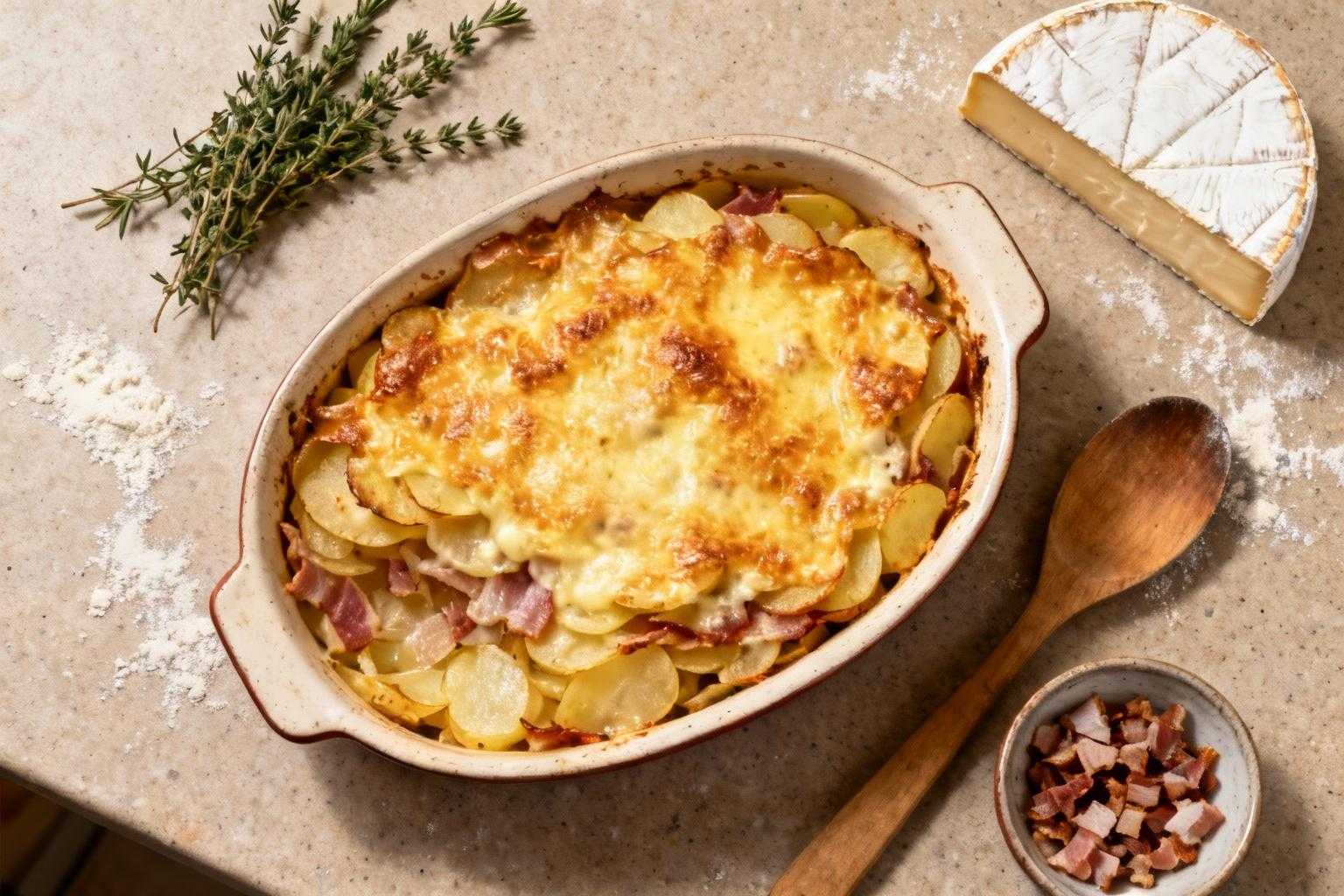There’s something magical about Alpine comfort food that speaks to our souls on cold evenings. Growing up, my grandmother would prepare tartiflette whenever our family gathered for winter celebrations, and the aroma of melting Reblochon cheese would fill our home with promises of indulgence. This iconic dish from the Savoie region of France may appear humble—simply potatoes, cheese, and bacon—but the transformation that happens in the oven creates something truly extraordinary that has warmed French mountain families for generations.
The Alpine Heritage of Tartiflette 🏔️
Tartiflette emerged from the snow-capped Savoie region in the French Alps, evolving from an older traditional dish called “péla.” While many assume it’s centuries old, tartiflette as we know it today was actually popularized in the 1980s as the perfect après-ski meal. What makes this dish special is how it showcases Reblochon—a creamy, washed-rind cheese that melts into liquid gold—transforming simple ingredients into something magnificent.
In my travels through small mountain villages, I discovered that regional families each had their slight variations, but they all agreed: the Reblochon cheese, not the potatoes, makes this dish truly iconic.
Essential Ingredients 🧾
For 6 servings, you’ll need:
- 2 pounds (900g) waxy potatoes (Yukon Gold works beautifully)
- 1 wheel (450g) Reblochon cheese, cut horizontally through the middle
- 7 ounces (200g) smoked lardons or thick-cut bacon, diced
- 2 medium onions (200g), finely chopped
- ¼ cup (60ml) dry white wine (preferably from Savoie)
- 2 tablespoons (30g) butter
- 2 cloves garlic, peeled
- 2 sprigs fresh thyme
- Freshly ground black pepper
Chef’s Note: Can’t find Reblochon? While not traditional, a combination of Brie and Gruyère can approximate its creamy-nutty character. The authentic dish, however, shines brightest with true Reblochon, which develops an intoxicating aroma as it bakes. If you can find it, it’s worth the effort—check specialty cheese shops or French markets.
Step-by-Step Instructions 📝
- Preheat your oven to 375°F (190°C).
- Cut one garlic clove in half and rub the inside of a 10-inch (25cm) gratin dish, then butter generously. This old French technique creates a subtle aromatic foundation.
- Peel the potatoes and slice them about ¼ inch (0.5cm) thick. Add to a pot of cold, salted water and bring to a gentle boil. Cook until just tender when pierced with a knife, about 8-10 minutes. Be careful not to overcook—they should hold their shape.
- While the potatoes cook, heat a large skillet over medium heat. Add the lardons and cook until golden and crisp, about 5-7 minutes. Using a slotted spoon, transfer to a paper towel-lined plate.
- In the same pan with the rendered bacon fat, add the chopped onions and remaining minced garlic. Cook until soft and translucent, about 5 minutes.
- Pour in the white wine, stirring to deglaze the pan and scrape up any browned bits—these contain concentrated flavor. Add thyme leaves and reduce slightly, about 2 minutes.
- Drain the potatoes thoroughly and gently fold them into the onion mixture, being careful not to break them. Season with freshly ground black pepper (the bacon and cheese already provide ample salt).
- Layer half the potato mixture in the prepared gratin dish, sprinkle with half the crispy lardons, then arrange half of the Reblochon (cut side down, rind side up) on top.
- Repeat the layers, finishing with the remaining Reblochon, making sure the rind faces upward.
- Bake in the preheated oven for 25-30 minutes, until gloriously golden and bubbling.
The Chef’s Secret Techniques 🤫
The magic of tartiflette lies in its deceptive simplicity. Three techniques elevate this from good to transcendent: First, always place the Reblochon rind-side up—this creates the perfect golden, crispy top while protecting the cheese beneath from burning. Second, don’t discard the bacon fat—it’s liquid gold for sautéing your onions. Finally, allow your tartiflette to rest for 10 minutes after baking. This brief patience allows the molten cheese to settle slightly, making serving easier and flavors more developed.
When I was training in the Alps, an elderly chef taught me to add the cold potatoes directly to the hot onion mixture rather than mixing in a separate bowl. “This way,” she whispered, “the potatoes drink up all the flavor from the pan.” It’s these small details that transform home cooking to restaurant quality.
Serving & Presentation Tips 🍽️
Serve your tartiflette straight from the oven in its baking dish—this rustic presentation honors its alpine heritage. The contrast between the golden, bubbling top and the creamy interior makes for a stunning presentation that needs nothing more than a simple green salad dressed with a sharp vinaigrette to cut through the richness. For an authentic French alpine experience, pair with a crisp Savoie white wine like Roussette or Jacquère.
If you’re exploring French cuisine, you might also enjoy trying your hand at Parisian-Style Nutella Crepes for dessert or Smoky Maple Glazed Salmon for a lighter meal. For chocolate lovers, my Triple Chocolate Mousse Cake pairs beautifully with tartiflette for a complete French-inspired feast.
When I serve tartiflette to friends who’ve never experienced it, I always tell them the same thing my grandmother told me: “This dish isn’t just food—it’s an alpine hug on a plate.” The way the cheese melts into the potatoes, how the smoky bacon provides little bursts of flavor—it’s comfort in its purest form. And in today’s world, couldn’t we all use a little more comfort? From my kitchen to yours, bon appétit!
